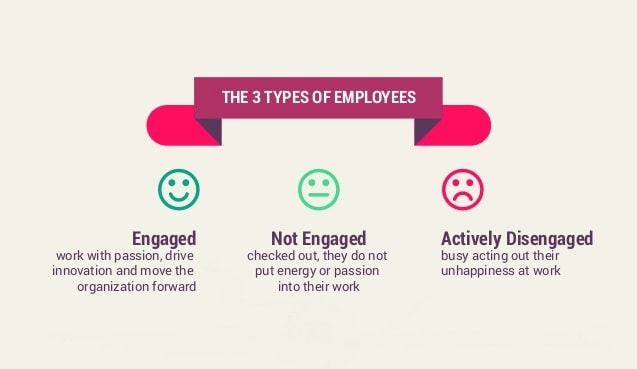There are multiple, sometimes conflicting definitions of what employee engagement actually is, and it is frequently confused with similar things which it is not, such as internal communication and job satisfaction. Experts cannot agree about whether it is an attitude, behaviour or outcome, or a combination of all three, or if it is an individual or group level phenomenon.

However, one thing is certain, evidence can be readily obtained to demonstrate that employee engagement correlates strongly with company performance, and as it can be both measured and dramatically improved by the employer, it an important tool for building business success.

So just what is an engaged employee? Gallup, a U.S. organisation providing management consulting, human resources and statistical research services, has defined these three employee types: engaged, not engaged and actively disengaged.

Engaged Employees
The best possible employees, the ones every employer wants. They are dedicated to their role, less likely to leave the company, more productive, give better customer service and in turn create greater profit in private sector organisations (Gallup, 2005). They are the builders in an organisation, driving innovation and moving the company forward.

They have a strong desire to know the expectations for their roles so they can both meet and exceed them (Coffman, 2003). They take pride in their work and will put in extra time to get a task completed to a good standard, not for financial gain but out of a personal sense of commitment- known as discretionary effort (Frank et al, 2004). Engaged employees are advocates of their company and will speak positively about them to others and encourage them to use their services (Gallup 2003).

They are rarely absent due to sickness (an average of 2.69 days annually in the UK- Gallup, 2003) and are more likely to believe that their work has a positive effect on their physical health (Crabtree, 2005).
Non-engaged Employees
These employees are ‘checked out’ and ‘sleepwalking’ through their day (Gallup, 2005) simply doing the necessary; attending work and getting the basic requirements of the job done without interest, energy, passion or any personal investment.

Pleasant enough and often with good attendance, they are in low-risk, low commitment mode, often focused entirely on the steps that they take to reach any goal, and not on the goal itself (Coffman 2002). They are usually neither negative nor positive about their company, adopting a ‘wait-and-see’ attitude to their jobs, managers and co-workers (Coffman 2003).

Where engaged employees will put in additional effort as part of their everyday working pattern, non-engaged employees are interested only in getting by and will not be willing to work extra without e.g. financial inducement or a similar persuader.
Actively Disengaged Employees
Disengaged employees are unhappy in their work and often don’t care who knows it. They are acting out their unhappiness (Gallup, 2005).

They are ‘consistently against virtually everything’ (Coffman 2003). Their work will be sloppy and/or of poor quality, their attendance inconsistent as they take more sick days (about 6.19 each year- Gallup 2003) and they are much more likely to leave the company than an engaged employee.

They may be highly vocal in their complaints and criticisms against the company undermining colleague’s attempts at maintaining a positive attitude and atmosphere and their careless approach to their work may reduce any advantage generated by more willing team mates.

Away from work they are more likely to denigrate their employer or at least to fail to recommend them to others (Gallup 2003), report that work stress has caused them to argue with family and friends (Gallup 2005) and state that work is damaging their health (Crabtree, 2005).


















